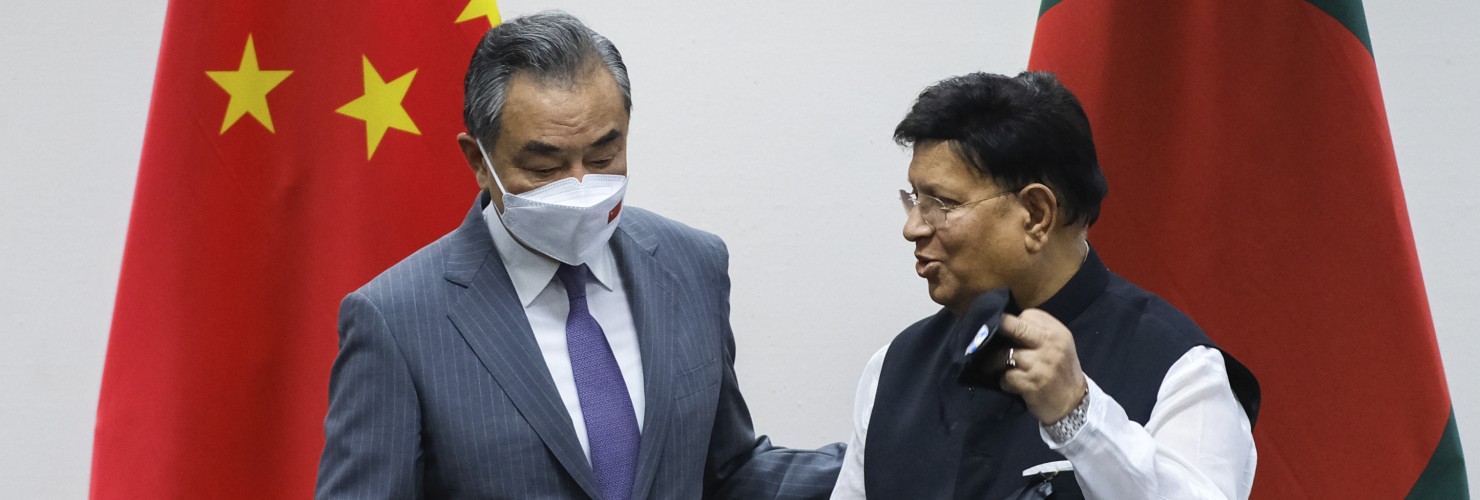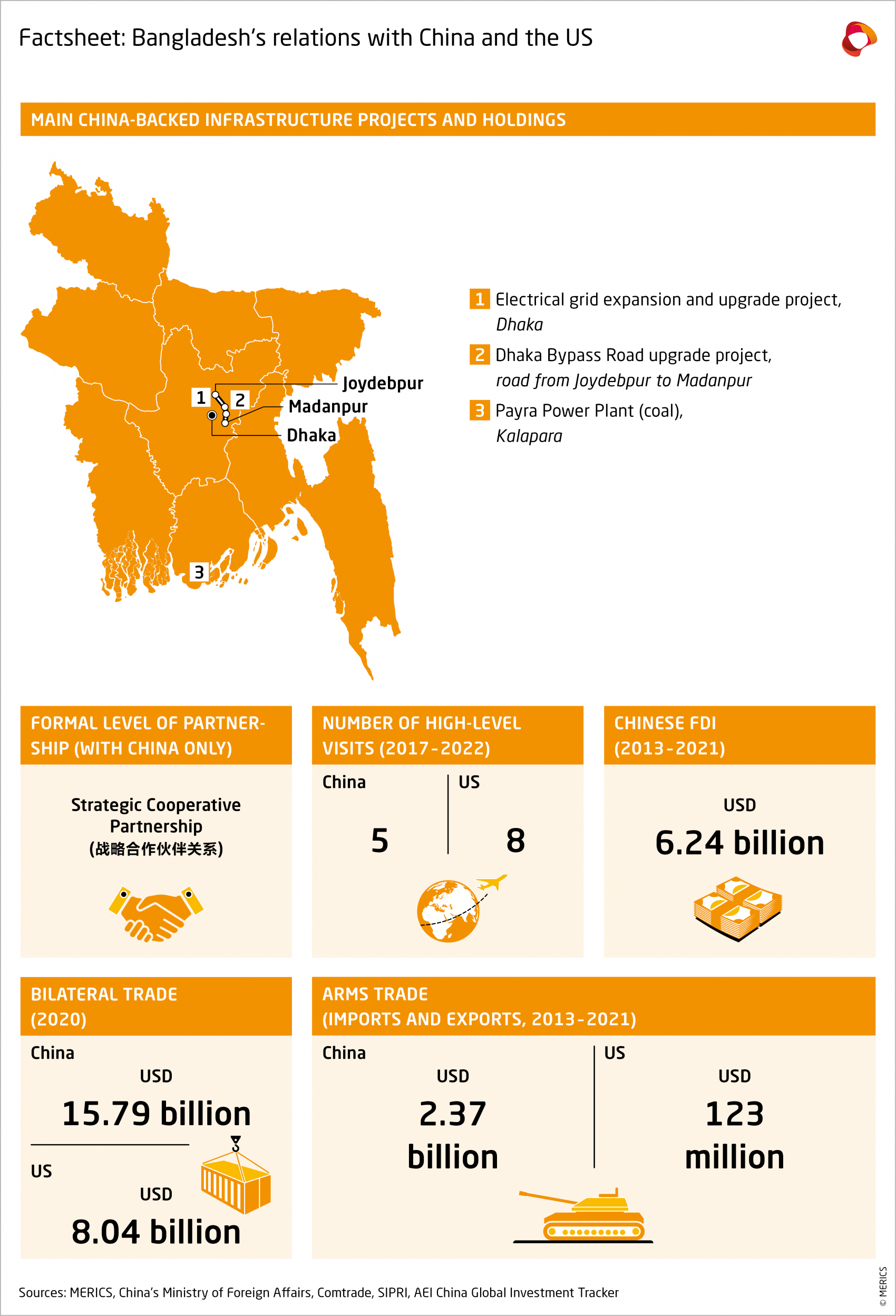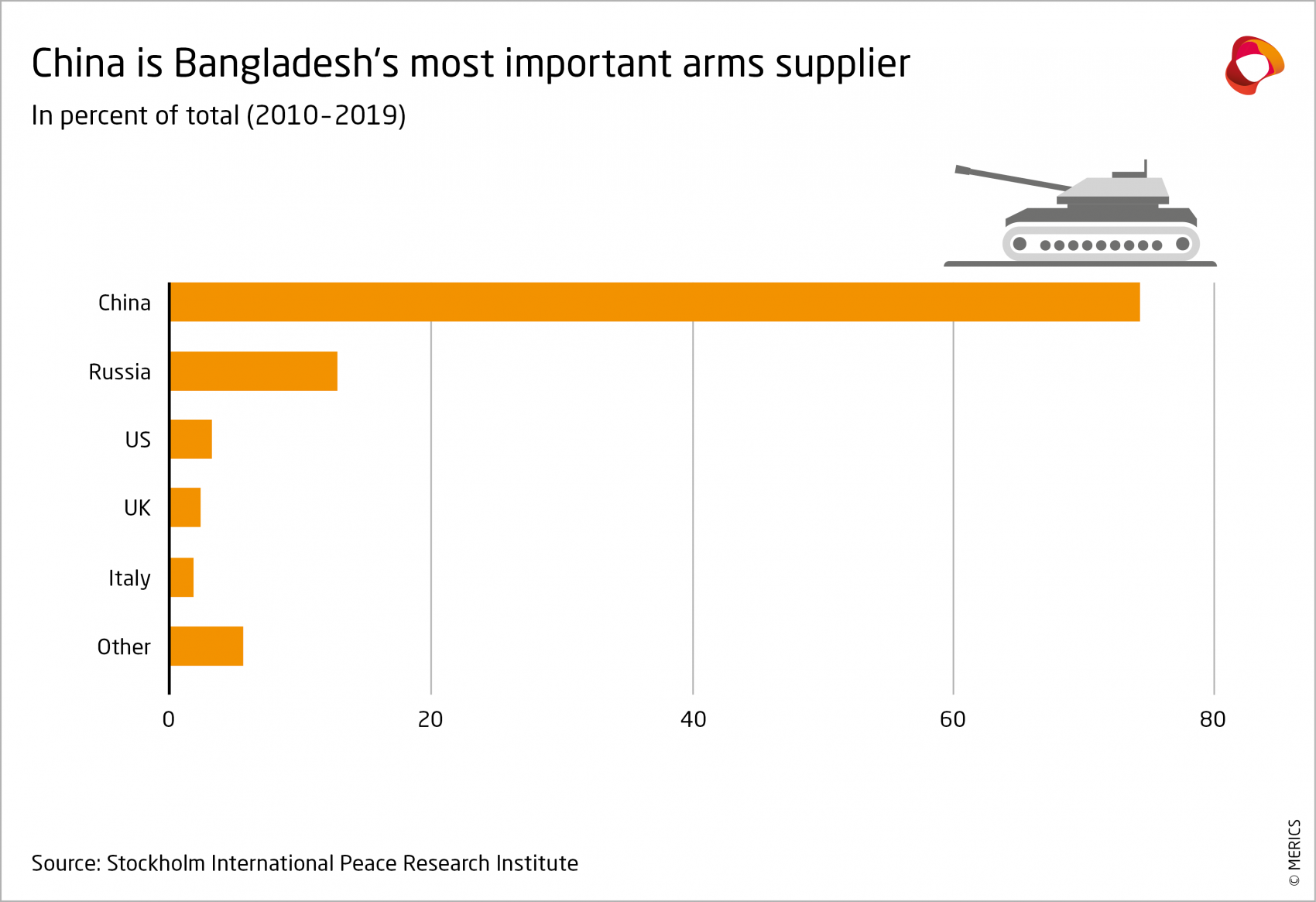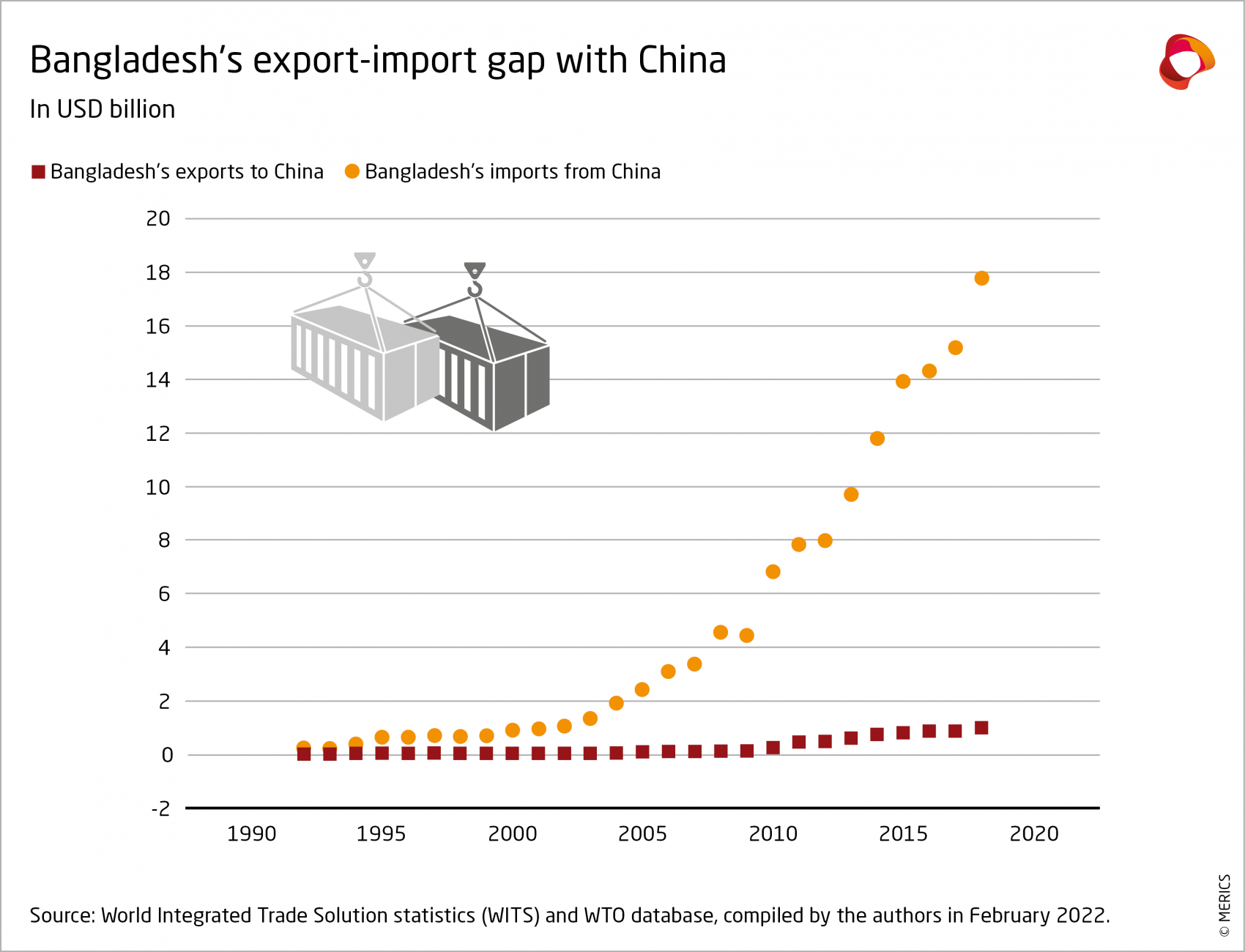

China-Bangladesh relations: A three way balance between China, India and the US
 You are reading chapter 1 of the MERICS Paper on China "Beyond blocs: global views on China and US-China relations". Click here to go to the table of contents.
You are reading chapter 1 of the MERICS Paper on China "Beyond blocs: global views on China and US-China relations". Click here to go to the table of contents.
In 2021, China’s President Xi Jinping sent a congratulatory message to Bangladesh on the 50th anniversary of its independence that encapsulates mutual aspirations for stronger ties in an age of great power competition. Both countries were “at a crucial stage of revitalization and development” when China’s “dream of great national rejuvenation can well connect with the “Sonar Bangla” [Golden Bangladesh] dream,” China’s president said. In 2016, President Xi became the first Chinese president to visit Bangladesh in 30 years. Bilateral relations were not always smooth and warm. China’s position towards Bangladesh has evolved over the 50 years since 1971 from hostility into a reluctant embrace and is now a “strategic partnership.” Current Bangladesh-China relations rest on a mix of pragmatism, strategic ambiguity, and political accommodation. Bangladesh and China have built a deep interdependence which is tilting increasingly in China’s favor.
Status quo: Evolving as never before
Bangladesh’s ties with China have come a long way since the country split from Pakistan, China’s ally, in the 1971 liberation war. Cold War realities meant China aligned with Pakistan, its all-weather friend, and opposed Bangladesh’s independence. As a permanent member of the United Nations Security Council (UNSC), China used its first veto power to deny UN membership to Bangladesh in 1972.1 They eventually established formal bilateral relations in 1975 but prior to that China’s approach consisted primarily of countering Bangladesh to reassure its ally Pakistan.
Sino-Bangladesh relations have improved steadily since then, evolving into a cornerstone of Bangladesh’s foreign policy.2 Convergences in their strategic calculations – for instance, their mutual view of India as a common threat – and economic incentives are the principal drivers of improving relations.
Chinese officials made their first high-level visit in 1978, which set off improvements in bilateral relations. Greater momentum came in 2013, with the launch of China’s Belt and Road Initiative (BRI). Dhaka formally joined the BRI during President Xi’s visit to Bangladesh in 2016, when relations were upgraded to a strategic partnership.3 BRI membership has brought Bangladesh an influx of Chinese investment totaling USD 38.05 billion, roughly equal to 10 percent of Bangladesh’s gross domestic product, the largest sum ever pledged to Bangladesh by a single country.4 China is now Bangladesh’s top trading partner,5 direct foreign investor, trade importer, and military hardware supplier. In 2020, China also granted duty-free access to its market for 97 percent of Bangladeshi products.6
Defense cooperation has been the main building block7 in the Sino-Bangladesh relationship: China’s economic footprint is a relatively new and an ever-increasing dimension, but defense cooperation has been the main component of the relationship. Since the early 1980s, the two armed forces have engaged in frequent high level official visits and have held joint training and exercises to strengthen cooperation. China has become Bangladesh’s top source of military hardware. Dhaka, likewise, is China’s second-largest arms export destination, behind only Pakistan.8 In the 2010-19 period, China accounted for 72 percent of Bangladesh’s total arms imports.9
Geopolitics: Founded on pragmatism and ambiguity
In Bangladeshi geopolitics, India has long been at the center due to its geographic proximity, cultural links and above all its intervention as an ally against Pakistan during Bangladesh’s liberation war. Meanwhile as a global power, the United States has exercised the greatest economic and political leverage over Bangladesh. Other regional powers, such as China and Japan, had a more peripheral role until China’s rise as an economic and military power cemented its ability and confirmed its willingness to exert influence beyond its borders into South Asia, providing Bangladesh an opportunity for a new partner to the north.
Bangladesh recognized the new opportunity that China represents; realpolitik began to dictate its foreign policy calculations, powered primarily by economic incentives. China’s appeal lay in the contrast with India’s hegemonic posture, coercive tactics, and resource scarcity, especially when garlanded with China’s practice of non-interference in Bangladesh’s domestic affairs. Massive investments in infrastructure and other sectors sealed China’s allure. As Bangladesh-China ties continue to deepen, India worries that its traditional regional partner may follow the same path as Nepal and Sri Lanka which are clearly hedging towards Beijing.
Consequently, Dhaka faces the risk of becoming embroiled in a China-India tug of war for regional influence.10 It has so far avoided this trap by maintaining balanced relations with both, emphasizing political and cultural affinities with India and economic ties with China.11 This balancing act is growing more challenging as competition between Beijing and New Delhi for regional influence intensifies. Dhaka therefore views the United States as a strategic ‘third-way-balancer’ and has proactively reached out to Washington for economic assistance and support in international forums so as to defuse tension and lessen Bangladeshi reliance on India and China.
The United States has exported USD 110 million worth of arms to Bangladesh since 2010, a meagre amount compared to the USD 2.59 billion Bangladesh has spent on Chinese military equipment.12 Faced with the heated Sino-Indian relationship caused by renewed Himalayan border clashes from May 2020, the United States took a proactive approach to courting Bangladesh. It proposed a military modernization plan, starting with Apache helicopters and missiles.13 Deeper security cooperation is of “mutual interest, with full respect for Bangladesh’s sovereignty and independence of action” according to Laura Stone, the US State Department’s then deputy assistant secretary for South Asia.14
The United States remains Bangladesh’s largest export destination – accounting for 14.5 percent of total exports, primarily garments, which are the country’s main export and foreign currency lifeline.15 Although China has granted duty-free access to 97 percent of Bangladeshi products, its own manufacturing prowess limits the market possibilities for Bangladeshi exports. Germany remains the top export destination for Bangladesh’s garment trade, taking USD 6.20 billion – worth of items in 2021; Germany is Bangladesh’s second largest market overall, accounting for 14.2 percent of total exports.16
China is gaining ground in the fierce competition between India and China. In 2015, it displaced India as Bangladesh’s top trading partner, knocking India out of the position it had held for 40 years. Imports from China represented 34 percent of Bangladesh’s total imports in 2019.17 Given China was also the origin of Bangladesh’s highest investment from a single source, and the bilateral strategic partnership, New Delhi naturally felt it was falling behind. In response, India has deployed a wide variety of tools – rather asymmetric but significant - to counter China’s inroads.18
Bangladesh has long wanted to build a deep-sea port on the Bay of Bengal, giving the project a high priority on the national agenda. China had pursued the Bangladesh government for decades to construct the Sonadia project. However, India’s opposition led to the scrapping of the Sonadia project altogether.19 Recognizing geopolitical realities, Bangladesh welcomed Japanese funding to build a deep-sea port in Matarbari.20 Beijing’s purchase of a 25 percent share in Bangladesh’s largest stock market, the Dhaka Stock Exchange (DSE), when it outbid India’s National Stock Exchange (NSE), took their struggle into new arenas. The sphere of China-India competition expanded from hard infrastructure into soft assets.21
Perceptions: China’s economy and neutrality win strong support
While the Bangladeshi population’s perception of China is overwhelmingly positive, the degree of enthusiasm varies among the political, military, and business elites and ordinary citizens. In 2014, the Pew research survey found 77 percent of Bangladeshis viewed China positively, the highest positive rating for all countries. By contrast, India continues to be seen as a potential threat to Bangladesh’s security by significant sections of the populace and elites.22 Overall, 43 percent of Bangladeshis prefer the United States as an ally.23 The lack of national unity and consensus has long been a major stumbling block for Bangladesh’s nation building process. The two major political parties – the Awami League and the Bangladesh Nationalist Party – rarely agree on anything except closer ties with Beijing.
China owes its popularity to the skillfully created perception that it is politically neutral and non-interfering as it has refrained from public comments on internal Bangladeshi issues.24 As a result, China benefits from general acceptance, which is reflected in political discourse. Bangladeshi leaders are often labelled as “pro-India” or “anti-India” which is not the case for China.
Bangladesh’s military and business community tend to be the strongest advocates of deeper Bangladesh-China relations. Military planners see a convergence with China in strategic calculations, given that India engulfs Bangladesh on three sides and hostile neighbor Myanmar shares the only other land border. Likewise, China sees long-term strategic interest in strengthening ties with India’s neighbors. It therefore provides sophisticated military hardware at comparatively low prices that Bangladesh could not obtain elsewhere. However, Bangladeshis have reservations about China’s ties with Myanmar to weigh against their positive attitude to convergence with China to buffer against India. Nonetheless, military ties with China are long-standing and deep-rooted.
In contrast, ties to China among Bangladesh’s business communities are relatively new but evolving fast. They are seeing profits as Chinese investment, trade and exports ramp up across multiple sectors, from physical to digital infrastructure. They have positive perceptions of China; like anywhere else, these business communities seek to influence the outlook of political, military and intellectual elites.
Broadly-speaking, perceptions of China and the United States seem uniformly positive. As Bangladesh is the world’s fourth largest Muslim-majority country, predominantly positive views of the United States there contrast with the Muslim world’s prevailing perceptions. Among Bangladeshis, 76 percent view the United States favorably, the highest level in the subcontinent.25 However, when it comes to comparisons with India, the perception of China is increasingly positive.
The differing perceptions of these three countries can be seen in responses to the Covid-19 pandemic. China fell short in supplying vaccines to Bangladesh, despite its intense Covid diplomacy, whereas the United States prioritized Bangladesh. The United States donated 38.4 million vaccine doses, while China provided only 5 million.26 Anti-India sentiment rose to its highest level when the Indian firm Serum Institute failed to fully deliver a pre-paid government order for vaccines. Bangladesh then had no option except to purchase vaccines from China.27
Outlook: Future friction is possible over trade, water and refugees
Bangladesh may face further isolation from the West due to its backsliding from democracy. The trend can be seen in recent US actions: for instance, the sanctioning of individuals by the US Treasury Department for human rights violations – a first for Bangladesh.28 Nor was Bangladesh among the 110 countries invited to President Joseph Biden’s Democracy summit in December 2021.29 These are unfavorable signs for the current regime, which has shown little appetite for pluralistic society. Such moves may motivate the regime to seek further ties with Beijing, as a potential economic lifeline that comes without criticisms of civil liberties failings.
While Bangladesh-China relations have strengthened considerably, there are three major areas of contention that loom large.
First, Bangladesh faces the challenge of hosting millions of Rohingya refugees. Beijing has failed to pressure the Myanmar junta as Dhaka had hoped, prioritizing instead China’s geopolitical and economic interests in Myanmar. In future, Dhaka’s frustration may rise if China maintains its current stance on the Rohingya crisis, with increasing impacts on Bangladesh. The issue could potentially damage China’s friendly image in Bangladesh.
Second, the growing trade imbalance with China is a concern for Bangladesh. Although China grants duty-free access to 97 percent of Bangladeshi products, it is inconceivable that Bangladesh can cut its trade gap with the world’s factory. In 2018, Bangladeshi imports from China amounted to USD 17.75 billion, while Bangladeshi exports to China were worth only USD 985.41 million, resulting in a trade deficit ratio between Dhaka and Beijing of 1:17.3.30
Third, China’s ambition to build dams along the upper Brahmaputra River poses serious concerns for Bangladesh as a downstream country.31 The Brahmaputra is among Bangladesh’s main water sources for agriculture, forestry, and fisheries; three sectors that together account for 12.5 percent of total GDP.32 If China carries out the plan, it could create a major stumbling block in the warming ties between the two countries.
In conclusion, Bangladesh’s strategic choices continue to be shaped by great powers, as they were when Pakistan and India fought a direct war over Bangladesh’s independence backed by the United States and USSR. The acceleration of US-China strategic competition will influence Bangladesh’s options and trajectory. In South Asia, their rivalry increasingly manifests as a competition between China and India, with Bangladesh as the battleground.
Bangladesh seeks to manage these tensions by triangulating within the US-China-India matrix. It pursues cooperation with China as a tool to promote its economic development, while reaching out to the United States as an extra-regional power, to balance the China-India tensions that stem from its close economic links to China. Bangladesh pursues ‘strategic ambiguity’ in foreign and defense policy by engaging with each country sector-wise. To balance, navigate and position itself, Bangladesh has accelerated its US ties to defuse tensions with the help of a ‘third-way-balancer.’ It aims to protect itself amid intensifying great-power competition in South Asia as relations between Beijing-New Delhi and Beijing-Washington worsen.
- Endnotes
-
1 | Alden, Robert. The New York Times (1972) “China’s First U.N. Veto Bars Bangladesh,” August 26. https://timesmachine.nytimes.com/timesmachine/1972/08/26/79474254.html?pageNumber=1. Accessed: January 20, 2022.
2 | Peng, Nian, Ghulam Ali and Yi Zhang (ed) 2022. Crossing the Himalayas: Buddhist ties, regional integration and great-power rivalry. Zaman Rashed U, Bangladesh’s Quest for Development and the Sino-Indian Contestation, Springer, Singapore https://doi.org/10.1007/978-981-16-5808-2
3 | Karim, R. and Liton, S. The Daily Star (2016) “Strategic partners.” October 15. https://www.thedailystar.net/frontpage/strategic-partners-1298923. Accessed January 20, 2022
4 | Mirdha Refayet, The Daily Star (2016). “Deals with China a turning point for Bangladesh,” October 17. https://www.thedailystar.net/business/deals-china-turning-point-bangladesh-1299802. Accessed January 22, 2022
5 | See: The Financial Express (2019) “BD-China trade to hit $18b mark in two years,” March 16. https://thefinancialexpress.com.bd/economy/bangladesh/bd-china-trade-to-hit-18b-mark-in-two-years-1552742734. Accessed: January 22, 2022
6 | See: Dhaka Tribune (2020) “97% Bangladeshi products to get duty-free access to China,” June 19. https://archive.dhakatribune.com/business/2020/06/19/5-161-more-bangladeshi-products-to-enjoy-zero-tariff-to-chinese-markets-from-july-1. Accessed: January 22, 2022
7 | Note: During the 2010-15 period, Beijing provided Dhaka with five maritime patrol vessels, two submarines, 16 fighter jets, and 44 tanks, as well as anti-ship and surface-to-air missiles . Most recently, in 2017 the Bangladesh Navy took delivery of two Ming-class Chinese submarines at minimum price, for ‘Forces Goal-2030’ to modernize its armed forces as a three-dimensional warfighting force. As Bangladesh’s aspiration to modernize its armed forces is likely to accelerate, Bangladesh-China military to military ties have prospects for further improvements.
8 | See: China Power, CSIS “ How Dominant is China in the Global Arms Trade” https://chinapower.csis.org/china-global-arms-trade/. Accessed: January 22, 2022
9 | Bekkevold, J. I. (2021). “India in China’s grand strategy, change and continuity from 1949 to present.” In J. I. Bekkevold and S. Kalyanaraman, eds., India’s great power politics, managing China’s rise. London and New York: Routledge, p. 38
10 | Cookson Forrest, Joehnk Ton F, East Asia Forum (2018), “China India’s geopolitical tug of war for Bangladesh”, April 11 https://www.eastasiaforum.org/2018/04/11/china-and-indias-geopolitical-tug-of-war-for-bangladesh/. Accessed: February 3, 2022
11 | Anwar Anu, The Diplomat (2019), “How Bangladesh Is Benefiting From the China-India Rivalry” July 12 https://thediplomat.com/2019/07/how-bangladesh-is-benefiting-from-the-china-india-rivalry/. Accessed: February 3, 2022
12 | ANAS A.Z.M. Nikkei Asia (2020) “US uses defense diplomacy to woo Bangladesh away from China,” September 22, https://asia.nikkei.com/Politics/International-relations/US-uses-defense-diplomacy-to-woo-Bangladesh-away-from-China. Accessed: January 27, 2022
13 | Hasan Asif M. East Asia Forum (2021) “China’s charm offensive in Bangladesh,” October 21 https://www.eastasiaforum.org/2021/10/21/chinas-charm-offensive-in-bangladesh/. Accessed: January 28, 2022
14 | See: US Department of State Press Briefing with Assistant Deputy Secretary of State Laura Stone, September 15, 2020 https://2017-2021.state.gov/online-press-briefing-with-deputy-assistant-secretary-of-state-laura-stone-bureau-of-south-and-central-asian-affairs-and-joanne-wagner-deputy-chief-of-mission-us-embassy-dhaka-bangladesh/index.html
15 | See: Bangladesh Profile https://oec.world/en/profile/country/bgd
16 | See: Comparative Statement on Export of RMG & Total Export of Bangladesh, BGMEA. https://www.bgmea.com.bd/page/Export_Performance
17 | See: country profile: Bangladesh https://oec.world/en/profile/country/bgdyearSelector2=importGrowthYear25
18 | Note: India announced USD 5 billion in loans for Bangladesh in 2017, which is the largest amount ever invested by India in Bangladesh. When China provided two Ming class Type 035G submarines to Bangladesh’s Navy, India responded with a submarine for Myanmar. To court Myanmar and send a signal to Dhaka, India also assists Myanmar’s military junta and provides diplomatic support despite global pressure over genocide against the Rohingyas.
19 | Ramachandran, Sudha, Bangladesh Buries the Sondia Deep-Sea Port Project, The Diplomat, October 12, 2020 https://thediplomat.com/2020/10/bangladesh-buries-the-sonadia-deep-sea-port-project/
20 | Shawon, Ali Ashif, Matarbari deep sea port by 2025, Dhaka Tribune, September 23, 2020 https://archive.dhakatribune.com/bangladesh/2020/09/23/matarbari-deep-sea-port-by-2025
21 | Kabir, A. Forbes (2018) “China outbids India for Bangladesh’s largest stock exchange: May 16, https://www.forbes.com/sites/arafatkabir/2018/05/16/china-outbids-india-for-bangladeshs-largest-stock-exchange-whatsnext/sh=b1af8b47f2c7. Accessed: January 25, 2022
22 | Johannes Plagemann (2021) “Small states and competing connectivity strategies: what explains Bangladesh’s success in relations with Asia’s major powers?” The Pacific Review, DOI: 10.1080/09512748.2021.1908410
23 | See: The only survey of its kind ever conducted. PEW research survey (2014) “How Asians view each other” https://www.pewresearch.org/global/2014/07/14/chapter-4-how-asians-view-each-other/
24 | Bhattacharjee Joyeeta, Observer Research Foundation (2018), “Decoding China-Bangladesh relationship,” June 27 https://www.orfonline.org/expert-speak/41935-decoding-china-bangladesh-relationship/ Accessed: February 3, 202225 | Ibid
26 | See: China’s Covid-19 vaccine tracker https://bridgebeijing.com/our-publications/our-publications-1/china-covid-19-vaccines-tracker/. Accessed: February 3, 2022
27 | See: DW (2021) “COVID: Bangladesh faces vaccine shortage as India halts exports,” https://www.dw.com/en/bangladesh-india-coronavirus-vaccine/a-57200281. Accessed: February 3, 2022
28 | See: Press release of the US Department of the Treasury, December 10, 2021 https://home.treasury.gov/news/press-releases/jy0526. Accessed: February 4, 2022
29 | See: The Business Standard (2021) “Bangladesh is not invited to Biden’s Democracy Summit,” November 24 https://www.tbsnews.net/world/bangladesh-not-invited-bidens-summit-democracy-333901. Accessed: February 4, 2022
30 | DCCI, Bangladesh-China Bilateral Trade. 2020, Dhaka Chamber of Commerce and Industries (DCCI), Accessed in December 2021: Dhaka Bangladesh; https://www.dhakachamber.com/
Database of UN COMTRADE, UN, Editor. 2020: USA; https://comtrade.un.org/
WTO Time Series Data (Accessed in December 2020). 2020; http://stat.wto.org/Home/WSDBHome.aspx Bank, B., Bangladesh Bank Open Data Initiative. 2020: Dhaka, Bangladesh (Accessed in December 2021); https://www.bb.org.bd/econdata/
31 | Wuthnow Joel, Limaye Satu, Samarnayake Nilanthi; War on The Rock (2020) “Brahmaputra: A Conflict- Prone Rive Takes a Step Backwards” December 23 https://warontherocks.com/2020/12/a-conflict-prone-river-takes-a-step-backwards/. Accessed February 4, 2022
32 | See: The World Bank data: Agriculture, forestry, and finishing, value added (% of GDP)—Bangladesh https://data.worldbank.org/indicator/NV.AGR.TOTL.ZSlocations=BD
 You were reading chapter 1 of the MERICS Paper on China "Beyond blocs: global views on China and US-China relations". Click here to go to the table of contents.
You were reading chapter 1 of the MERICS Paper on China "Beyond blocs: global views on China and US-China relations". Click here to go to the table of contents.



